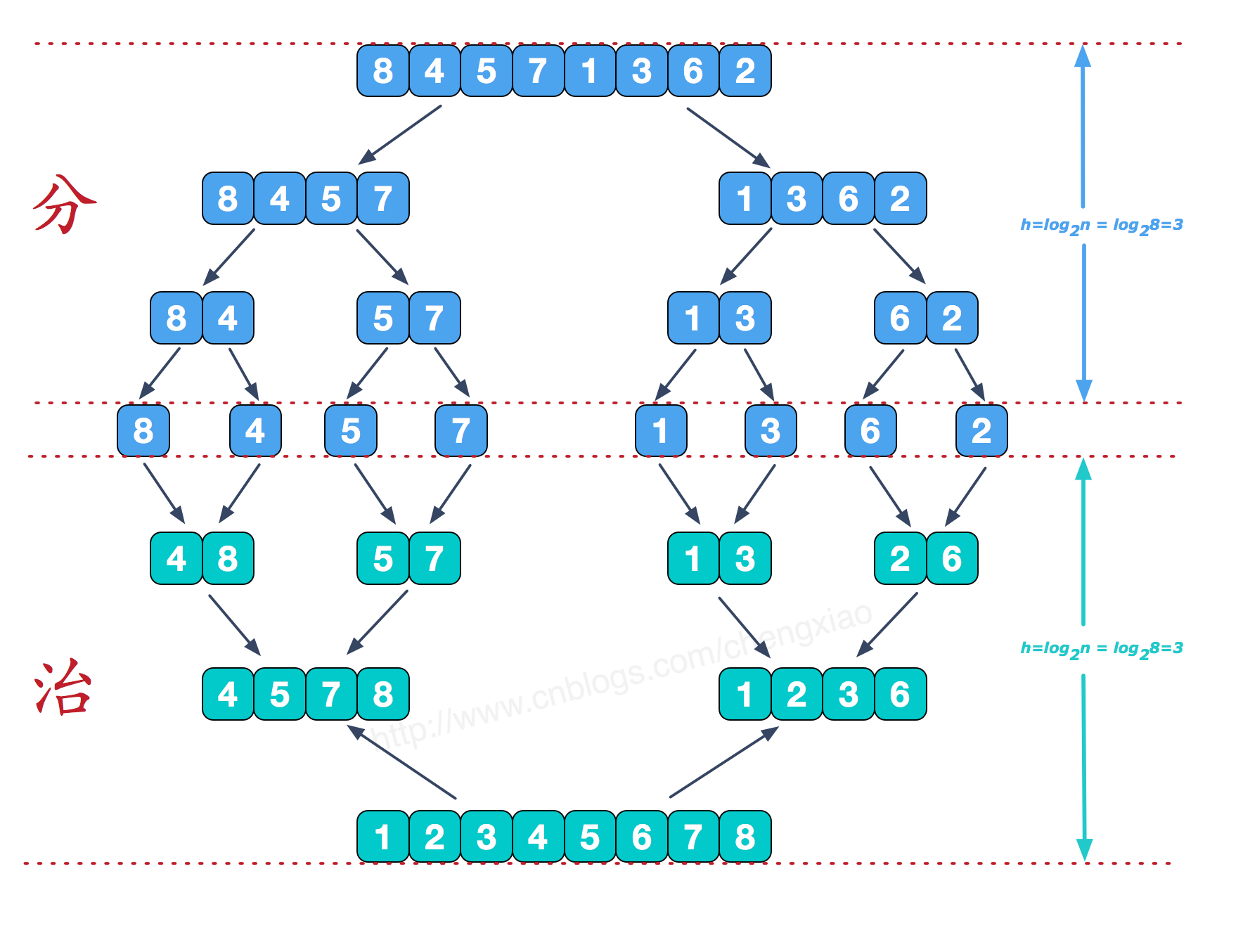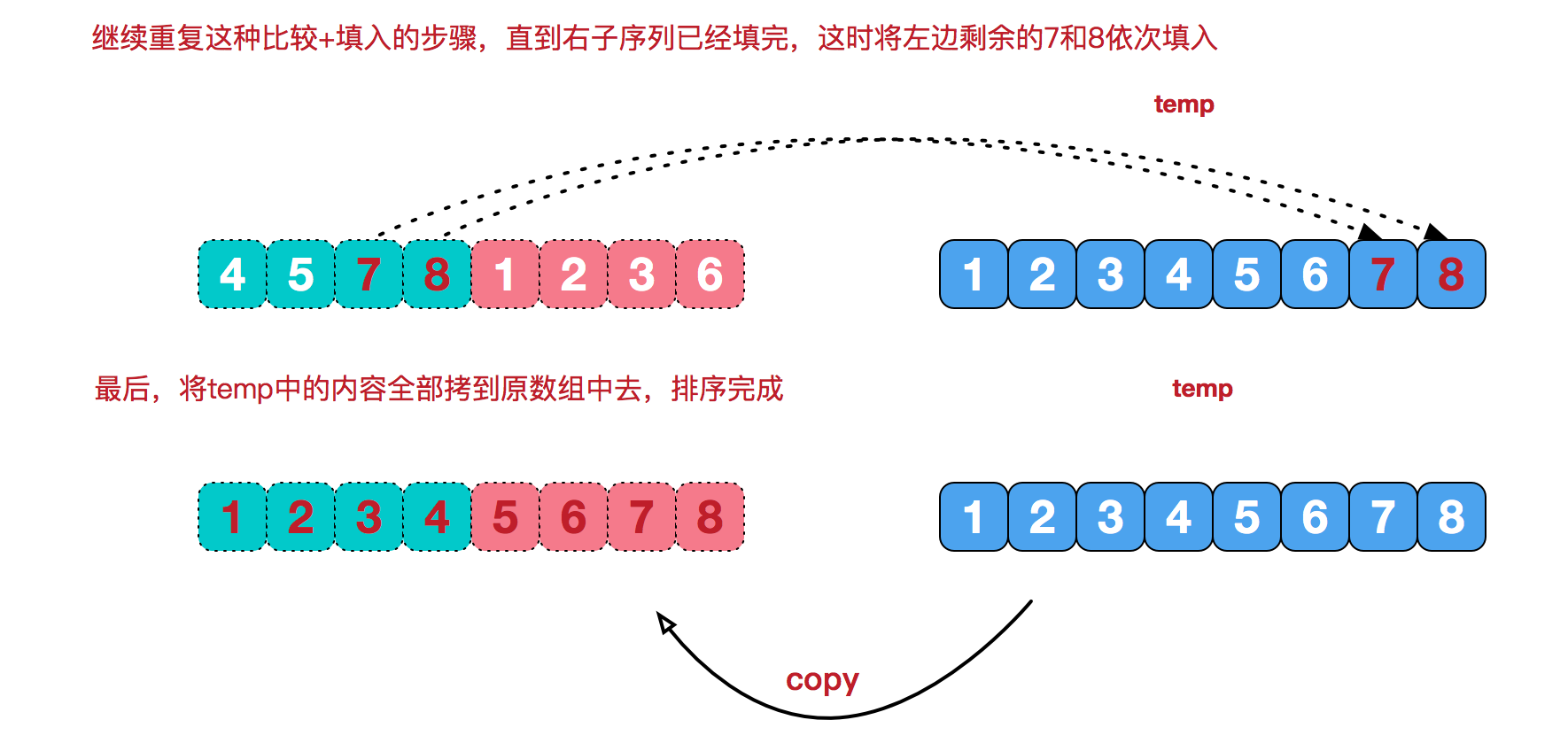归并排序(MERGE-SORT)是利用归并的思想实现的排序方法,该算法采用经典的分治(divide-and-conquer)策略(分治法将问题分(divide) 成一些小的问题然后递归求解,而治 (conquer)的阶段则将分的阶段得到的各答案 “修补” 在一起,即分而治之)。
分而治之

可以看到这种结构很像一棵完全二叉树,本文的归并排序我们采用递归去实现(也可采用迭代的方式去实现)。分阶段可以理解为就是递归拆分子序列的过程,递归深度为 log2n。
再来看看治阶段,我们需要将两个已经有序的子序列合并成一个有序序列,比如上图中的最后一次合并,要将[4,5,7,8]和[1,2,3,6]两个已经有序的子序列,合并为最终序列[1,2,3,4,5,6,7,8],来看下实现步骤。



package sortdemo; import java.util.Arrays; /* Created by chengxiao on 2016/12/8. */
public class MergeSort { public static void main(String []args){ int []arr = {9,8,7,6,5,4,3,2,1};
sort(arr);
System.out.println(Arrays.toString(arr));
} public static void sort(int []arr){ int []temp = new int[arr.length];// 在排序前,先建好一个长度等于原数组长度的临时数组,避免递归中频繁开辟空间
sort(arr,0,arr.length-1,temp);
} private static void sort(int[] arr,int left,int right,int []temp){if(left
sort(arr,mid+1,right,temp);// 右边归并排序,使得右子序列有序
merge(arr,left,mid,right,temp);// 将两个有序子数组合并操作
}
} private static void merge(int[] arr,int left,int mid,int right,int[] temp){ int i = left;// 左序列指针
int j = mid+1;// 右序列指针
int t = 0;// 临时数组指针
while (i<=mid && j<=right){ if(arr[i]<=arr[j]){
temp[t++] = arr[i++];
}else {
temp[t++] = arr[j++];
}
} while(i<=mid){// 将左边剩余元素填充进 temp 中
temp[t++] = arr[i++];
} while(j<=right){// 将右序列剩余元素填充进 temp 中
temp[t++] = arr[j++];
}
t \= 0; // 将 temp 中的元素全部拷贝到原数组中
while(left <= right){
arr[left++] = temp[t++];
}
}
}

执行结果
[1, 2, 3, 4, 5, 6, 7, 8, 9]
归并排序是稳定排序,它也是一种十分高效的排序,能利用完全二叉树特性的排序一般性能都不会太差。java 中 Arrays.sort() 采用了一种名为 TimSort 的排序算法,就是归并排序的优化版本。从上文的图中可看出,每次合并操作的平均时间复杂度为 O(n),而完全二叉树的深度为 | log2n|。总的平均时间复杂度为 O(nlogn)。而且,归并排序的最好,最坏,平均时间复杂度均为 O(nlogn)。
https://www.cnblogs.com/chengxiao/p/6194356.html
import java.util.*;public class Main {public static int mergeSort(int[] array, int left, int right) {if (right - left <= 0) {// 不能再分return 0;} else {int mid = (left + right) / 2;// 不停的进行划分int count = mergeSort(array, left, mid) + mergeSort(array, mid + 1, right);// 用来保存数据的临时数组ArrayList<Integer> temp = new ArrayList<>();// 前半部分的指针int i = left;// 后半部分的指针int j = mid + 1;// 开始比较,直到一个指针达到边界while (i <= mid && j <= right) {if (array[i] <= array[j]) {temp.add(array[i]);i++;} else {count += mid - i + 1;temp.add(array[j]);j++;}}while (i <= mid) {temp.add(array[i++]);}while (j <= right) {temp.add(array[j++]);}for (int k = 0; k < right - left + 1; k++) {array[left + k] = temp.get(k);}return count;}}public static void main(String[] args) {Scanner scan = new Scanner(System.in);int num = scan.nextInt();while (num > 0) {int length = scan.nextInt();int[] array = new int[length];for (int i = 0; i < length; i++) {array[i] = scan.nextInt();}int result = mergeSort(array, 0, length - 1);System.out.println(result);num--;}}}

